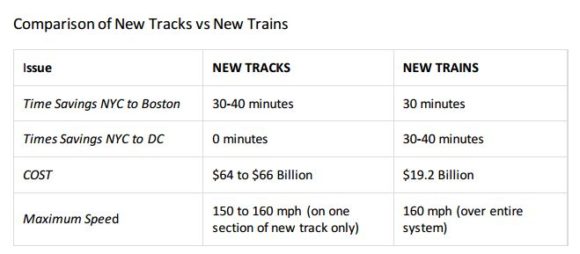An Open Letter to the Members of the FRA:
I support high speed rail service. This country needs to find the most efficient transportation system possible to make us the most sustainable country on earth. The world is urbanizing at a rapid rate which makes mass transit a critical part of the solution. That means making both local and long distant rail so attractive that people drive and fly much less. This lowers our carbon footprint, increases our productivity and makes our lives easier. When you travel to China you realize we are living 50 years in the past!
I have reviewed the Northeast Corridor EIS and specifically the FRA preferred Alternate 1 and would like to make a counter proposal. I recommend a two part plan that provides a near term solution for improved local and regional Northeast Corridor Rail Service (STEP ONE) and long term solution for dramatically reduced high speed rail travel (STEP TWO).
STEP ONE : NEW TRAINS NOT NEW TRACKS!
Use existing tracks with new trains for improved high speed rail and better commuter rail. This part of the plan is quite simple. To save 30 minutes off the current Acela travel time from NYC to Boston we can spend $65 billion on a major new rail project from Old Saybrook, CT to Kenyon RI, OR we can spend less than $20 billion on completely new high speed trains running from DC to NYC to Boston. We can spend $20 billion or $65 billion to save 30 minutes of time. It seems like an easy decision. Buy new trains for $19.2 billion.
In fact with all new trains we can save a total of 70 minutes from DC to Boston, up to 40 minutes on DC to NYC and 30 minutes from NYC to Boston. By spending $65 billion we also bypass lots of rail dependent towns and destroy numerous historic towns along the way. For $20 billion we make NO changes to the landscape, we just get lighter more fuel efficient trains that are designed to run at higher speeds on curvy tracks. We adopt the same type of trains used in Europe and Asia but precluded for almost a century in the US based on a 1920’s Federal Law. When the Acela’s were built we took efficient lighter weight trains from Europe and overbuilt them which made them too fat and heavy to bank on the curves. And they use more energy to move all that weight.
For more information on the recommended new trains read this article from 2013 titled, “High Speed ‘Trains of the Future’ May Finally be Coming to the Northeast“and recent articles in the NY Times from this past Sunday.

STEP TWO : BUILD A REAL HIGH SPEED TRAIN TO SAVE 90 MINS!
Build a really fast route as the crow flies through NY-CT-MA to allow even the Maglev trains like in Shanghai. This would take a decade and cost a lot but long term it would reduce massive carbon emissions from air travel and car travel. This would be an investment in our future. This is the approach that France took to build the TGV.
We would now have a real high speed line and a very fast intercity rail line along the shoreline.
Please consider my recommended plan.
Sincerely,
Alex Twining,
Old Lyme
Editor’s Notes: i) Alex Twining is President & CEO of [ t ] TwiningProperties of New York, NY, and Cambridge, Mass. www.twiningproperties.com.
ii) This letter has been submitted to the FRA in reference to the public meeting being held Aug. 31, in the Lyme-Old Lyme High School auditorium.
I agree with much of your proposal. We already know that Step One has been taken, the trains are being ordered to replace the 20 year old Acela equipment. A real, long-term and resilient solution to the service between DC, NYC and Boston should involve Maglev or some other innovative technology but I would consider it as a Step Three if it can be show to be cost effective. What is missing is a solution to the multiple problems with the infrastructure of the existing local and regional NEC services. New. Trains will help but the bridges are obsolete and the trackage is vulnerable to climate changes.
If the FRA had performed routine maintenance in the last 100 years, our bridges would not be in disrepair. Pointing out their poor condition begs the issue. Federal government agencies like big spends. And their decisions are sacrosanct- sad but true. As you state, the original Acela trains were bad choices for our existing tracks. Now, there is a new multi-billion dollar spend to replace the aging Acela fleet. Talk about throwing good money after bad! Further, given the poor service, late trains, power interruptions and other ills of our current rail service, it’s no wonder people are skeptical and /or mistrusting of the FRA current mega-scope for the “Future” of the northeast corridor.
Here here Alex. I just returned from the Springfield MA open meeting held by the FRA. I had a chance to ask about the more efficient trains with one of their agents. He said the other issue with the existing tracks is they can’t handle the capacity of trains needing to run on this section of the line. (Saybrook to Boston ) NYC to new haven has six lanes of track to handle all the commuter activity.
So for your stage one we would need to consider how address this capacity need while repairing or replacing some antiquated bridges. Thoughts?